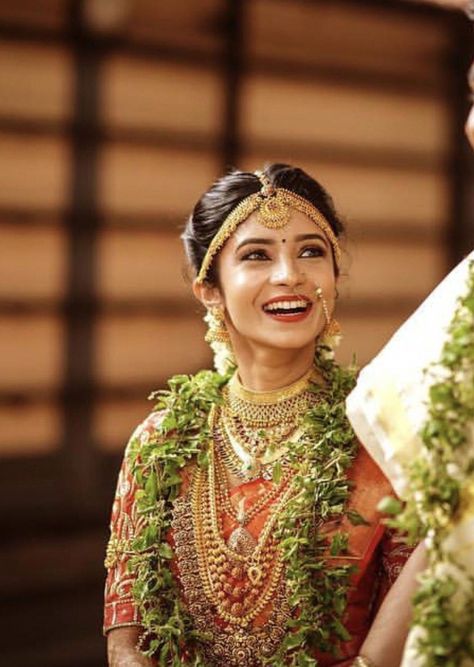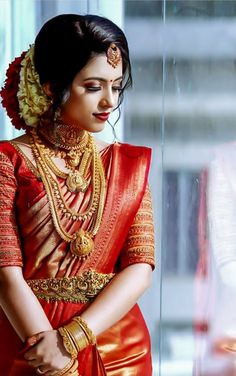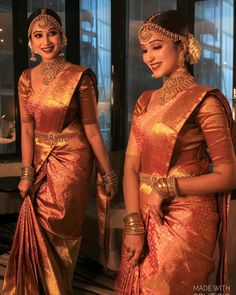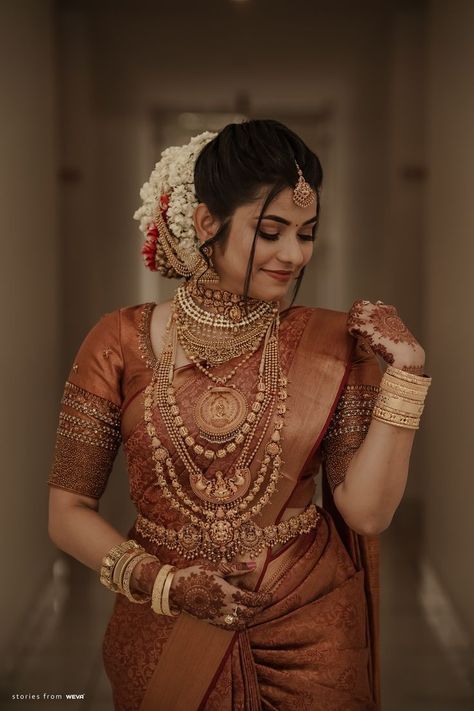South Indian Hindu Bridal
The wedding ceremony in South Indian Hindu culture is a grand affair, rich in tradition, symbolism, and cultural significance. From elaborate rituals and sacred ceremonies to vibrant attire and intricate jewelry, every aspect of the South Indian Hindu bridal experience is steeped in history and tradition. In this class note, we will explore the journey of a South Indian Hindu bride, from pre-wedding rituals to post-wedding traditions, delving into the intricate details that make this celebration truly unforgettable.

Pre-Wedding Rituals:
- Nischayam (Engagement): The journey of a South Indian Hindu bride typically begins with the nischayam or engagement ceremony, where the families of the bride and groom formally announce their intention to marry. It is an auspicious occasion marked by the exchange of rings, gifts, and blessings.
- Pendlikoothuru (Haldi Ceremony): The pendlikoothuru or haldi ceremony is a pre-wedding ritual where turmeric paste is applied to the bride’s and groom’s bodies to cleanse, purify, and beautify their skin. It is believed to ward off evil spirits and bless the couple with good fortune and prosperity.
- Mehendi Ceremony: The mehendi or henna ceremony is a festive occasion where intricate designs are applied to the bride’s hands and feet with henna paste. It is a symbol of beauty, fertility, and auspiciousness, with each design holding special significance and meaning.
- Muhurtham (Wedding Date Selection): The muhurtham or wedding date selection is a crucial aspect of South Indian Hindu weddings, with astrologers determining the most auspicious time and date for the ceremony based on the alignment of celestial bodies and astrological charts.
Wedding Attire:

- Kanjivaram Silk Saree: The traditional bridal attire for South Indian Hindu brides is the kanjivaram silk saree, renowned for its luxurious texture, vibrant colors, and intricate zari work. The saree is typically adorned with traditional motifs such as peacocks, elephants, and mangoes, symbolizing fertility, prosperity, and auspiciousness.
- Temple Jewelry: South Indian Hindu brides accessorize their bridal attire with exquisite temple jewelry, crafted from gold and embellished with precious stones such as rubies, emeralds, and pearls. The jewelry includes a mukutam (tiara), haar (necklace), kanganam (bangles), jhumkas (earrings), and oddiyanam (waist belt), symbolizing wealth, status, and marital bliss.
- Malli Poo (Jasmine Flowers): The bride adorns her hair with fragrant jasmine flowers, known as malli poo, symbolizing purity, beauty, and auspiciousness. The delicate white blossoms are woven into intricate garlands, braids, and bun adornments, adding a touch of elegance and charm to the bridal ensemble.
Wedding Rituals:
- Kashi Yatra: The groom embarks on a symbolic journey to Kashi (Varanasi), pretending to renounce worldly pleasures and become a sanyasi (ascetic). The bride’s brother intercepts him and convinces him to return, promising to give his sister’s hand in marriage. It is a playful yet meaningful ritual symbolizing the bond between the families and the groom’s commitment to marriage.
- Mangala Snanam: The bride and groom undergo a ceremonial bath, known as mangala snanam, to purify and sanctify their bodies before the wedding ceremony. It is a sacred ritual performed with turmeric, sandalwood paste, and holy water, symbolizing spiritual cleansing and renewal.
- Kanyadaan: The kanyadaan ceremony is the giving away of the bride by her parents to the groom, symbolizing the transfer of responsibility and care from one family to another. It is a poignant moment filled with blessings, prayers, and emotional exchanges, marking the beginning of a new chapter in the bride’s life.
- Saptapadi (Seven Steps): The saptapadi or seven steps is a sacred ritual where the bride and groom take seven symbolic steps together, representing their journey through life as partners and companions. With each step, they make vows and promises to each other, affirming their commitment, love, and mutual respect.

Post-Wedding Traditions:
- Grihapravesh: After the wedding ceremony, the bride is welcomed into her new home in a ritual known as grihapravesh. She enters the house with her right foot, symbolizing prosperity and good fortune, and is greeted with blessings, gifts, and warm hospitality from her new family members.
- Sumangali Prarthanai: The sumangali prarthanai is a ritual performed by married women (sumangalis) to seek blessings for the bride’s marital life and well-being. It involves prayers, rituals, and offerings made to the goddess Gauri, symbolizing the bride’s transition to married life and her role as a sumangali in the future.
Conclusion: The South Indian Hindu bridal journey is a tapestry of tradition, elegance, and cultural heritage, woven with rituals, attire, and customs that have been passed down through generations. From the vibrant colors of the kanjivaram silk saree to the intricate designs of temple jewelry, every aspect of the bridal ensemble symbolizes love, purity, and auspiciousness. Through this class note, we have explored the intricate rituals, elaborate attire, and timeless customs that make the South Indian Hindu bridal experience truly unforgettable, celebrating the beauty and splendor of this cherished tradition.


